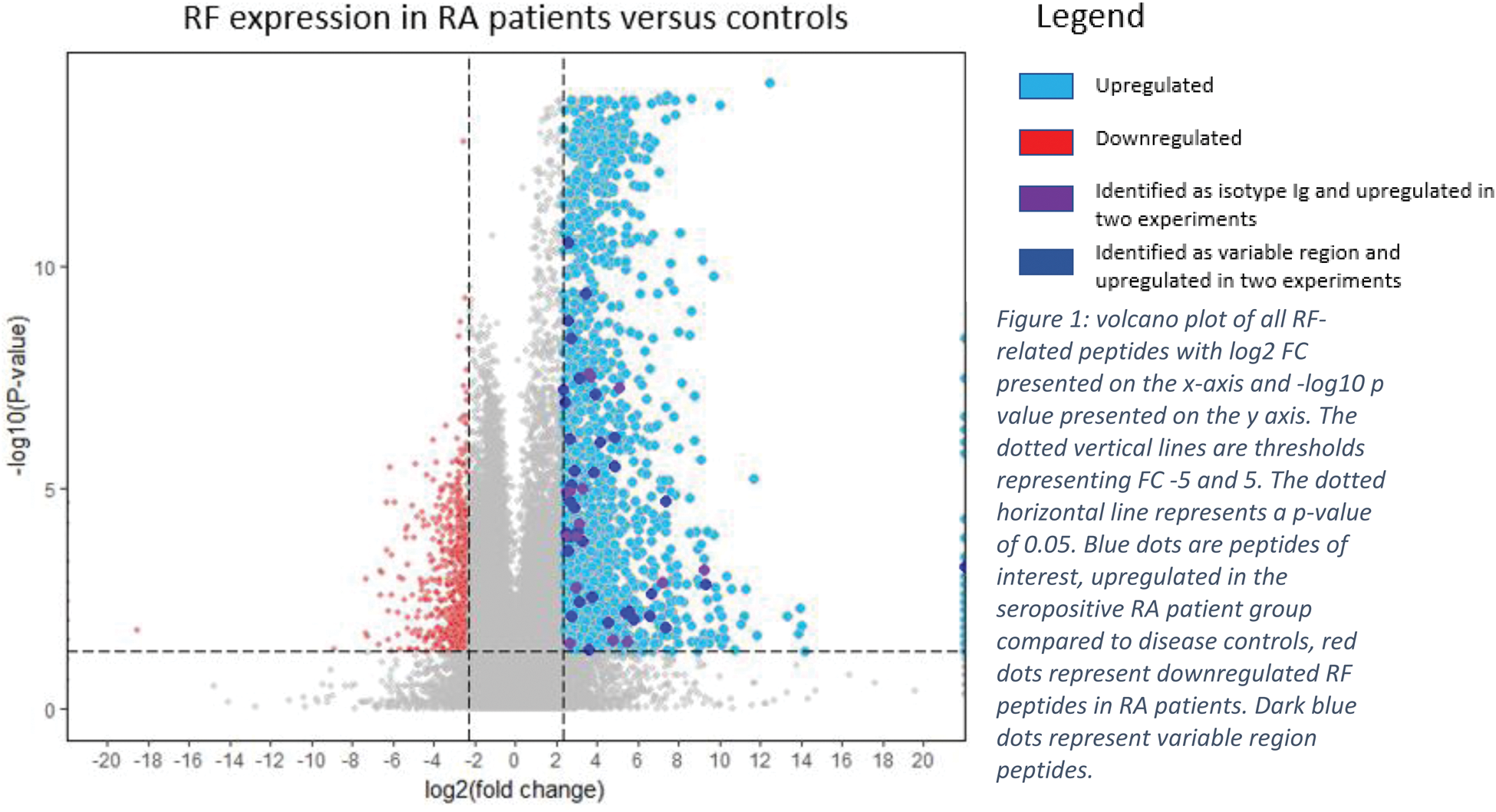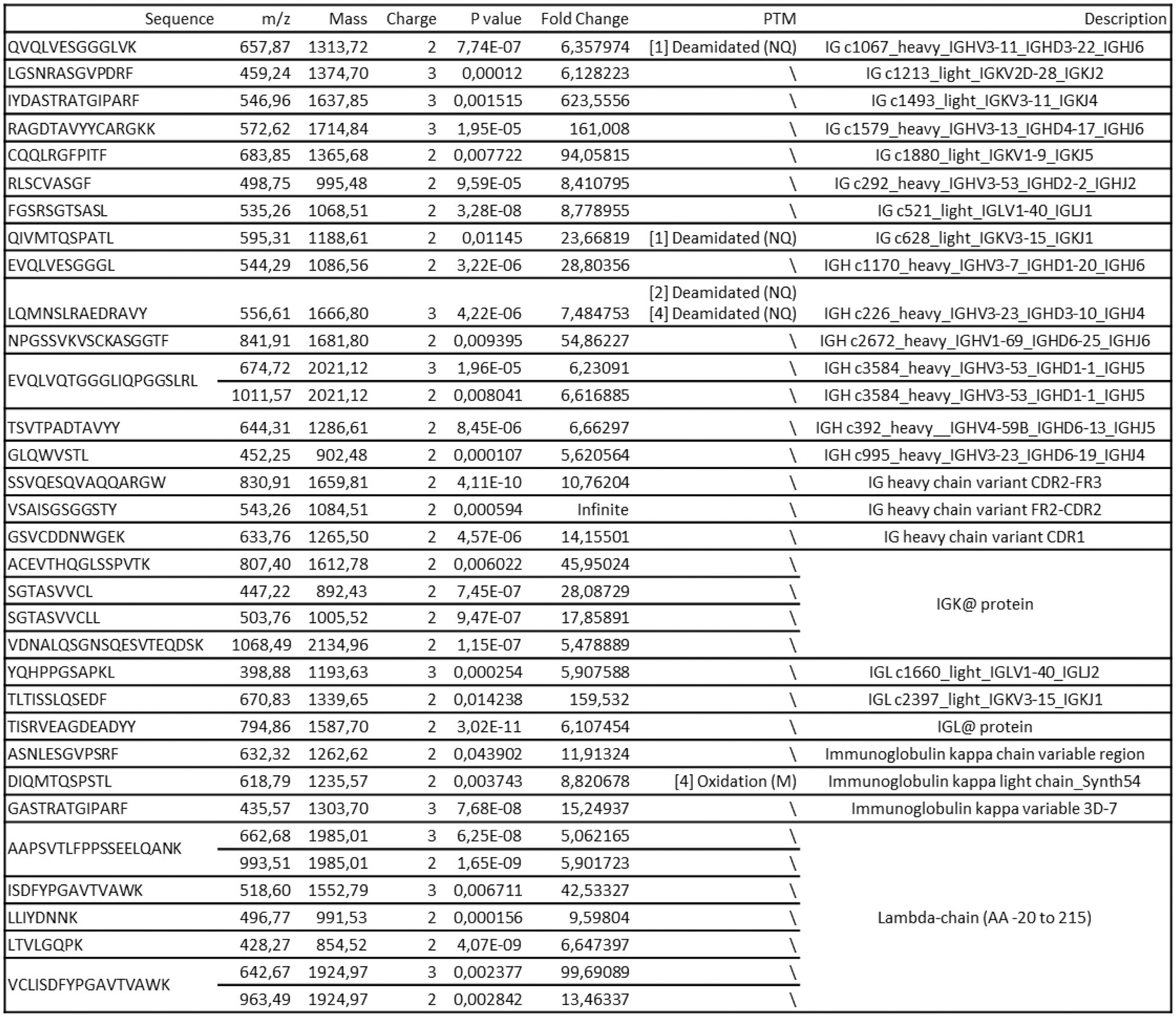

Background: Rheumatoid arthritis (RA) is a chronic autoimmune disease characterized by severe joint destruction resulting in impaired physical function when left untreated. Autoantibodies such as anti-citrullinated peptide (ACPA) and rheumatoid factor (RF) support RA diagnosis. However, in early-RA, more than one third of the patients are seronegative for ACPA/RF. Currently, the amino acid (AA) sequence of the variable region of RF is largely unknown. We hypothesize the presence of an overlap between RF in patients, and even possible in seronegative patients without autoantibody reactivity. Thus, the RF AA sequence could prove useful for future biomarker development.
Objectives: We aimed to describe AA sequence derived from the variable region of RF using liquid chromatography-tandem mass spectrometry (LC-MS/MS).
Methods: A pilot experiment was set-up using sera from 4 seropositive RA patients, 4 seronegative RA patients and 4 disease controls (DC). RA patients were obtained from an early-RA cohort (CareRA) [2]. RF was isolated from serum using an ELISA plate coated with Fc IgG, followed by in-plate digestion. Analysis of the digested peptides was performed using LC-MS/MS. The peptides of interest were identified by Mascot and matched with the Uniprot Human database with a threshold Mascot Score >20. Results were visualized by Volcano plots [fold change (FC) of intensities and p-value determined by Mann Whitney U-test]. In a follow-up experiment, serum samples from 29 seropositive and 23 seronegative RA patients were compared to 32 DC.
Results: Peptides were plotted in a volcano plot (Figure 1). From all peptides of interest, defined as having a p-value <0.05 and a FC >5 in both experiments and identified as variable region peptides, 32 peptides were identified in the seropositive patients compared to disease controls (Table 1). Remarkably, 5 seronegative patients and 2 DC were positive for at least 4 peptides of interest. Furthermore, proteotypic peptides from different RF isotypes (IgG, IgA and IgM) were revealed in different patients, illustrating the feasibility of this technique to differentiate RF isotypes. Furthermore, detection of different isotypes bypasses the need for ELISA’s with different secondary antibodies. In recent reviews, different isotype determination showed to be useful in seronegative patients to modify the diagnosis and management of the disease [2].
Conclusion: In these experiments, 32 variable region RF peptides were identified and validated with LC-MS/MS in serum of seropositive RA patients. These peptides were not present or significantly less abundant in DC. Interestingly, some seronegative patients proved positive for these peptides. In addition, this technique also allows to differentiate different RF isotypes per patient.
REFERENCES: [1] Verschueren P, De Cock D, Corluy L, Joos R, Langenaken C, Taelman V, Raeman F, Ravelingien I, Vandevyvere K, Lenaerts J, Geens E, Geusens P, Vanhoof J, Durnez A, Remans J, Vander Cruyssen B, Van Essche E, Sileghem A, De Brabanter G, Joly J, Meyfroidt S, Van der Elst K, Westhovens R. Methotrexate in combination with other DMARDs is not superior to methotrexate alone for remission induction with moderate-to-high-dose glucocorticoid bridging in early rheumatoid arthritis after 16 weeks of treatment: the CareRA trial. Ann Rheum Dis. 2015 Jan;74(1):27-34. doi: 10.1136/annrheumdis-2014-205489. Epub 2014 Oct 30. PMID: 25359382.
[2] Motta F, Bizzaro N, Giavarina D, Franceschini F, Infantino M, Palterer B, Sebastiani GD, Selmi C. Rheumatoid factor isotypes in rheumatoid arthritis diagnosis and prognosis: a systematic review and meta-analysis. RMD Open. 2023 Aug;9(3):e002817. doi: 10.1136/rmdopen-2022-002817. PMID: 37541740; PMCID: PMC10407415.
Volcano plot of all RF-related peptides with log2 FC presented on the x-axis and -log10 p value presented on the y axis. The dotted vertical lines are thresholds representing FC -5 and 5. The dotted horizontal line represents a p-value of 0.05. Blue dots are peptides of interest, upregulated in the seropositive RA patient group compared to disease controls, red dots represent downregulated RF peptides in RA patients. Dark blue dots represent variable region peptides.

Table 1. List of variable region peptides of interest after RF isolation. Description extracted from the Uniprot Human database.

Acknowledgements: NIL.
Disclosure of Interests: None declared.
© The Authors 2025. This abstract is an open access article published in Annals of Rheumatic Diseases under the CC BY-NC-ND license (